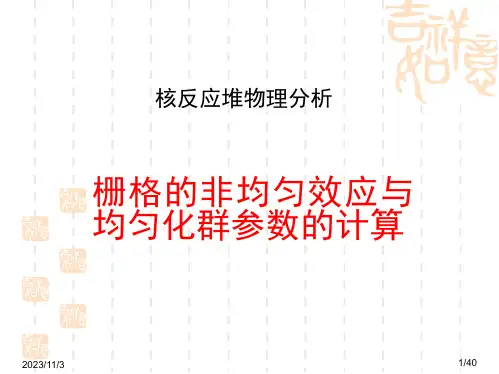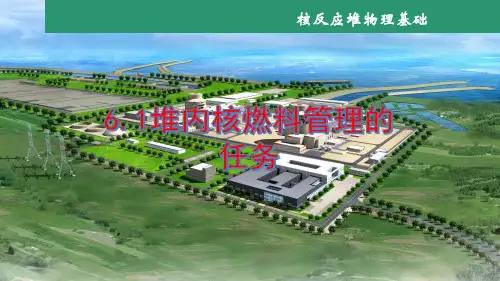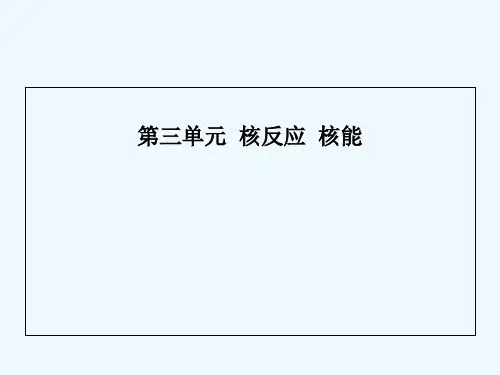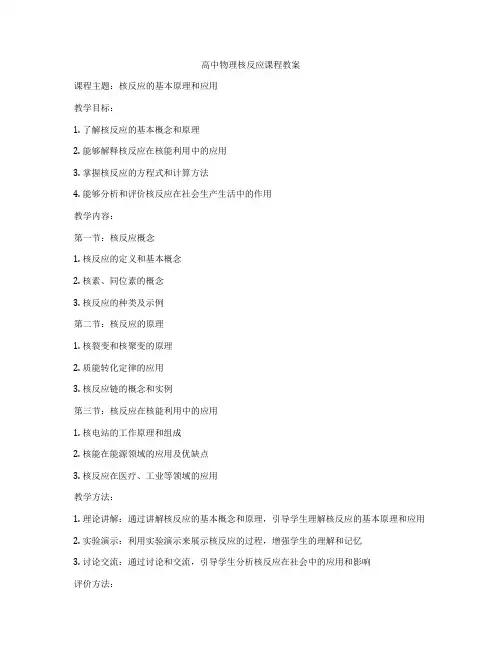《核反应物理分析》课程设计课件资料
- 格式:doc
- 大小:1.05 MB
- 文档页数:17



核反应课程设计一、课程目标知识目标:1. 学生能理解核反应的基本概念,掌握核反应的类型及特点;2. 学生能掌握质量数和电荷数守恒原则在核反应中的应用;3. 学生能了解核能的计算方法及其在能源领域的应用。
技能目标:1. 学生能运用所学知识分析核反应过程,正确书写核反应方程式;2. 学生能通过实验观察核反应现象,培养观察、分析和解决问题的能力;3. 学生能运用核能知识,进行简单的核能计算和能源转换分析。
情感态度价值观目标:1. 学生对核反应产生兴趣,培养对物理学科的好奇心和探索精神;2. 学生能认识到核能的巨大潜力和在能源领域的应用,树立正确的能源观念;3. 学生能了解核能的安全性和环保问题,培养社会责任感和伦理道德观念。
本课程针对高中物理学科,结合学生年级特点,注重理论与实践相结合,以提高学生的科学素养和实际应用能力。
课程目标具体、可衡量,旨在让学生在学习过程中,既能掌握核反应的基本知识,又能将其应用于实际问题的解决,同时培养正确的情感态度价值观。
为实现课程目标,教学设计将注重启发式、探究式和实验式教学方法,以促进学生全面、主动地发展。
二、教学内容本章节教学内容主要包括以下几部分:1. 核反应基本概念:核裂变、核聚变、人工转变等;- 教材章节:第三章第一节2. 核反应类型及特点:α衰变、β衰变、电子俘获等;- 教材章节:第三章第二节3. 质量数和电荷数守恒原则在核反应中的应用;- 教材章节:第三章第三节4. 核反应方程式的书写方法;- 教材章节:第三章第四节5. 核能的计算方法及其在能源领域的应用;- 教材章节:第三章第五节6. 核反应实验观察与现象分析;- 教材章节:第三章第六节7. 核能安全性和环保问题探讨;- 教材章节:第三章第七节教学进度安排如下:第一课时:核反应基本概念、类型及特点;第二课时:质量数和电荷数守恒原则在核反应中的应用;第三课时:核反应方程式的书写方法;第四课时:核能的计算方法及其在能源领域的应用;第五课时:核反应实验观察与现象分析;第六课时:核能安全性和环保问题探讨。




高三物理教案:《核反应教案》教学设计本文题目:高三物理教案:核反应教案核反应核能质能方程一、知识点梳理1、核反应在核物理学中,原子核在其它粒子的轰击下产生新原子核的过程,称为核反应.典型的原子核人工转变:N+ He O+ H 质子H的发现方程卢瑟福Be+ He C+ n 中子n的发现方程查德威克2、核能(1)核反应中放出的能量称为核能(2)质量亏损:原子核的质量小于组成它的核子质量之和.质量亏损.(3)质能方程:质能关系为E=mc2原子核的结合能ΔE=Δmc23、裂变把重核分裂成质量较小的核,释放出的核能的反应,叫裂变典型的裂变反应是:U+ n Sr+ Xe+10 n4.轻核的聚变把轻核结合成质量较大的核,释放出的核能的反应叫轻核的聚变.聚变反应释放能量较多,典型的轻核聚变为:H+ H He+ n5.链式反应一个重核吸收一个中子后发生裂变时,分裂成两个中等质量核,同时释放若干个中子,如果这些中子再引起其它重核的裂变,就可以使这种裂变反应不断的进行下去,这种反应叫重核裂变的链式反应二、典型例题例 1.雷蒙德?戴维斯因研究来自太阳的电子中微子(v。
)而获得了2002年度诺贝尔物理学奖.他探测中微子所用的探测器的主体是一个贮满615t四氯乙烯(C2Cl4)溶液的巨桶.电子中微子可以将一个氯核转变为一个氢核,其核反应方程式为νe+3717Cl→3718Ar十0-1e已知3717Cl核的质量为36.95658 u,3718Ar核的质量为36.95691 u,0-1e的质量为0.00055 u,1 u质量对应的能量为931.5MeV.根据以上数据,可以判断参与上述反应的电子中微子的最小能量为(A)0.82 Me V (B)0.31 MeV (C)1.33 MeV (D)0.51 MeV[解析]由题意可得:电子中微子的能量 E =mc2-(mAr+me-mCl)?931.5MeV=(36.95691+0.00055-36.95658)×931.5MeV=0.82MeV则电子中微子的最小能量为Emin=0.82MeV[点评] 应用爱因斯坦质能方程时,注意单位的使用。

高中物理核反应课程教案
课程主题:核反应的基本原理和应用
教学目标:
1. 了解核反应的基本概念和原理
2. 能够解释核反应在核能利用中的应用
3. 掌握核反应的方程式和计算方法
4. 能够分析和评价核反应在社会生产生活中的作用
教学内容:
第一节:核反应概念
1. 核反应的定义和基本概念
2. 核素、同位素的概念
3. 核反应的种类及示例
第二节:核反应的原理
1. 核裂变和核聚变的原理
2. 质能转化定律的应用
3. 核反应链的概念和实例
第三节:核反应在核能利用中的应用
1. 核电站的工作原理和组成
2. 核能在能源领域的应用及优缺点
3. 核反应在医疗、工业等领域的应用
教学方法:
1. 理论讲解:通过讲解核反应的基本概念和原理,引导学生理解核反应的基本原理和应用
2. 实验演示:利用实验演示来展示核反应的过程,增强学生的理解和记忆
3. 讨论交流:通过讨论和交流,引导学生分析核反应在社会中的应用和影响
评价方法:
1. 知识检测:通过考试和笔试检测学生对核反应相关知识的掌握程度
2. 实验报告:要求学生完成实验报告,评价其实验能力和分析能力
3. 课堂表现:评价学生在课堂上的积极性和学习态度
教学资源:
1. 教科书:《高中物理课本》
2. 实验仪器:核反应实验箱、核反应器等
3. 多媒体课件:包括视频、图片等展示核反应的过程
扩展活动:
1. 参观核电站:组织学生到当地核电站参观,加深对核反应原理的理解
2. 观看纪录片:推荐相关纪录片,帮助学生了解核反应在生产生活中的应用注:本教案仅供参考,具体教学内容和方法可根据实际情况进行调整。



目录题目1 (2)1.1 问题描述 (2)1.2 输入卡描述 (2)1.3 运行结果 (4)题目2 (5)2.1 问题描述 (5)2.2 输入卡描述 (5)2.3 运行结果 (7)题目3 (8)3.1 问题描述 (8)3.2 输入卡描述 (8)3.3 运行结果 (10)题目4 (11)4.1 问题描述 (11)4.2 输入卡描述 (12)4.3 运行结果与分析 (15)贡献及心得体会 (17)题目11.1问题描述试对下面描述的问题进行5000个中子,100次循环的临界计算。
1.如下图所示(注意坐标,可自行改变坐标),中间黑色部分为Pu239(100%)圆筒,外围包着的是天然U反射层,初始燃料源处于(3.5, 0, 0)点。
其数据如下:Pu: ρ=15.8g/ccU: ρ=18.8 g/cc质量百分比:U-238 99.2745%U-235 0.72%1.2 输入卡描述1.2.1 几何描述<?xml version="1.0"?><geometry><surface id="1" type="x-cylinder" coeffs="0 0 4.935" boundary="transmission"/> <surface id="2" type="x-plane" coeffs="0" boundary="vacuum"/><surface id="3" type="x-plane" coeffs="6.909" boundary="vacuum"/><surface id="4" type="x-cylinder" coeffs="0 0 9.935" boundary="vacuum"/><cell id="1" material="1" region="-1 2 -3" /><cell id="2" material="2" region="1 2 -3 -4" /><cell id="3" material="void" region="-2|3|4" /></geometry>1.2.2 材料描述<?xml version="1.0"?><materials><material id="1" ><density value="15.8" units="g/cc" /><nuclide name="Pu-239" xs="71c" ao="1"/></material><material id="2" ><density value="18.8" units="g/cc" /><nuclide name="U-235" xs="71c" wo="0.0072"/><nuclide name="U-238" xs="71c" wo="0.992745"/></material></materials>1.2.3源描述<?xml version="1.0"?><settings><eigenvalue><batches>100</batches><inactive>5</inactive><particles>5000</particles></eigenvalue><cross_sections> /home/liuwenmo/openmc-develop/data/nndc/cross_sections.xml </cross_sections><source><space type="point"><parameters>3.5 0 0</parameters></space></source></settings>1.3 运行结果与分析结果分析:题目22.1 问题描述如下图所示,中间黑色部分为Pu 239(100%)圆筒,外围包着的是天然U反射层, 初始燃料源处于(3.5, 0, 0)点。
其数据如下:Pu: ρ=15.8g/ccU: ρ=18.8g/cc原子百分比:238 99.2745%235 0.72%2.2 输入卡描述2.2.1 几何描述<?xml version="1.0"?><geometry><surface id="1" type="x-cylinder" coeffs="0 0 4.935" boundary="transmission"/><surface id="2" type="x-plane" coeffs="0" boundary="transmission"/><surface id="3" type="x-plane" coeffs="6.909" boundary="transmission"/> <surface id="4" type="x-cylinder" coeffs="0 0 9.935" boundary="vacuum"/> <surface id="5" type="x-plane" coeffs="-5" boundary="vacuum"/><surface id="6" type="x-plane" coeffs="11.909" boundary="vacuum"/><cell id="1" material="1" region="-1 2 -3" /><cell id="2" material="2" region="(1 2 -3 -4)|(-4 5 -3)|(-4 -6 2)" /><cell id="3" material="void" region="4|-5|6" /></geometry>2.2.2 材料描述<?xml version="1.0"?><materials><material id="1" ><density value="15.8" units="g/cc" /><nuclide name="Pu-239" xs="71c" ao="1"/></material><material id="2" ><density value="18.8" units="g/cc" /><nuclide name="U-235" xs="71c" wo="0.0072"/><nuclide name="U-238" xs="71c" wo="0.992745"/></material></materials>2.2.3源描述<?xml version="1.0"?><settings><eigenvalue><batches>100</batches><inactive>5</inactive><particles>5000</particles></eigenvalue><cross_sections> /home/liuwenmo/openmc-develop/data/nndc/cross_sections.xml </cross_sections><source><space type="point"><parameters>3.5 0 0</parameters></space></source></settings>2.3 运行结果与分析结果分析:题目33.1 问题描述Exercise 3 is a bare (unreflected) UO2F2solution cylinder.The weight percent of 235U in the uranium is 4.89 %. The solution has a radius of 20.12 cm and a height of 100.0 cm. An aluminum tank with a thickness of 0.1587 cm on the sides and bottom, and a height of 110.0 cm contains the solution. There is no lid on the tank. The region from the top of the solution to the top of the aluminum tank is void. The data for this problem follows:溶液密度:0.096586 atoms/b-cm 铝密度:2.7g/cc溶液原子百分比:H1: 5.7058e-2,O8:3.2929e-2,F9: 4.3996e-3,U238 2.0909e-3 U235 1.0889e-4初始燃料源位置(0 0 50)提示:描述溶液材料时要添加<sab name="HH2O" xs="71t" />3.2 输入卡描述3.2.1 几何描述<?xml version="1.0"?><geometry><surface id="1" type="z-cylinder " coeffs="0 0 20.12" boundary="transmission"/> <surface id="2" type="z-cylinder " coeffs="0 0 20.2787" boundary="vacuum"/> <surface id="3" type="z-plane " coeffs="0" boundary="transmission"/><surface id="4" type="z-plane " coeffs="100" boundary="transmission"/><surface id="5" type="z-plane " coeffs="110" boundary="vacuum"/><surface id="6" type="z-plane " coeffs="-0.1587" boundary="vacuum"/><cell id="1" material="1" region="-1 3 -4" /><cell id="2" material="void" region="-1 4 -5" /><cell id="3" material="2" region="(1 -2 -5 3 )|(-2 -3 6 )" /><cell id="4" material="void" region="2|5|-6" /></geometry>3.2.2 材料描述<?xml version="1.0"?><materials><material id="1" ><sab name="HH2O" xs="71t" /><density value="0.096586" units="atom/b-cm" /><nuclide name="H-1" xs="71c" ao="5.7058e-02"/><nuclide name="O-16" xs="71c" ao="3.2929e-02"/><nuclide name="F-19" xs="71c" ao="4.3996e-03"/><nuclide name="U-238" xs="71c" ao="2.0909e-03"/><nuclide name="U-235" xs="71c" ao="1.0889e-04"/></material><material id="2" ><density value="2.7" units="g/cc" /><nuclide name="AL-27" xs="71c" ao="1"/></material></materials>3.2.3源描述<?xml version="1.0"?><settings><eigenvalue><batches>100</batches><inactive>5</inactive><particles>5000</particles></eigenvalue><cross_sections> /home/liuwenmo/openmc-develop/data/nndc/cross_sections.xml </cross_sections><source><space type="point"><parameters>0 0 50</parameters></space></source></settings>3.3 运行结果与分析结果分析:题目44.1 问题描述有下图的栅元结构尺寸如下:栅距:13.3mm燃料棒外径:8.43mm包壳内径:8.6mm包壳外径:10mm包壳和燃料棒之间有空隙(真空)边界条件:栅元边界全反射燃料材料为UO2,,不同富集度下的原子个数之比为包壳材料密度为6.55 g/cc,成分为Sn 0.0126Fe0.00357Cr0.00192O0.00625Zr1.08(均为原子个数比)冷却剂材料:含硼水,硼浓度为1000ppm密度为0.75 g/cc其原子个数比为:H:2O:1B10:0.0003300248,B11:0.0013367669 计算不同富集度下栅元的有效增殖系数,并简单分析计算结果4.2 输入卡描述1.2.1 几何描述<?xml version="1.0"?><geometry><surface id="1" type="z-cylinder" coeffs="0 0 0.4215" boundary="transmission"/> <surface id="2" type="z-cylinder" coeffs="0 0 0.43" boundary="transmission"/> <surface id="3" type="z-cylinder" coeffs="0 0 0.5" boundary="transmission"/><surface id="4" type="x-plane" coeffs="0.665" boundary="reflective"/><surface id="5" type="x-plane" coeffs="-0.665" boundary="reflective"/><surface id="6" type="y-plane" coeffs="0.665" boundary="reflective"/><surface id="7" type="y-plane" coeffs="-0.665" boundary="reflective"/><cell id="1" material="1" region="-1" /><cell id="2" material="void" region="1 -2" /><cell id="3" material="2" region="2 -3" /><cell id="4" material="3" region="3 -4 5 -6 7" /></geometry>1.2.2 材料描述(1)当富集度为1.8%时<?xml version="1.0"?><materials><material id="1" ><density value="18.8" units="g/cc" /><nuclide name="U-235" xs="71c" wo="0.0182339772"/><nuclide name="U-238" xs="71c" wo="0.9817660228"/><nuclide name="O-16" xs="71c" wo="2"/></material><material id="2" ><density value="6.55" units="g/cc" /><nuclide name="Sn-119" xs="71c" wo="0.0126"/><nuclide name="Fe-56" xs="71c" wo="0.00357"/><nuclide name="Cr-52" xs="71c" wo="0.00192"/><nuclide name="O-16" xs="71c" wo="0.00625"/><nuclide name="Zr-91" xs="71c" wo="1.08"/></material><material id="3" ><sab name="HH2O" xs="71t" /><density value="0.75" units="g/cc" /><nuclide name="H-1" xs="71c" ao="2"/><nuclide name="O-16" xs="71c" ao="1"/><nuclide name="B-10" xs="71c" ao="0.0003300248"/><nuclide name="B-11" xs="71c" ao="0.0013367669"/></material></materials>(2)当富集度为2.4%时<?xml version="1.0"?><materials><material id="1" ><density value="18.8" units="g/cc" /><nuclide name="U-235" xs="71c" wo="0.024*******"/> <nuclide name="U-238" xs="71c" wo="0.9756861677"/> <nuclide name="O-16" xs="71c" wo="2"/></material><material id="2" ><density value="6.55" units="g/cc" /><nuclide name="Sn-119" xs="71c" wo="0.0126"/><nuclide name="Fe-56" xs="71c" wo="0.00357"/><nuclide name="Cr-52" xs="71c" wo="0.00192"/><nuclide name="O-16" xs="71c" wo="0.00625"/><nuclide name="Zr-91" xs="71c" wo="1.08"/></material><material id="3" ><density value="0.75" units="g/cc" /><nuclide name="H-1" xs="71c" ao="2"/><nuclide name="O-16" xs="71c" ao="1"/><nuclide name="B-10" xs="71c" ao="0.0003300248"/><nuclide name="B-11" xs="71c" ao="0.0013367669"/></material></materials>(3)当富集度为3.1%时<?xml version="1.0"?><materials><material id="1" ><density value="18.8" units="g/cc" /><nuclide name="U-235" xs="71c" wo="0.0314081743"/> <nuclide name="U-238" xs="71c" wo="0.9685918257"/> <nuclide name="O-16" xs="71c" wo="2"/></material><material id="2" ><density value="6.55" units="g/cc" /><nuclide name="Sn-119" xs="71c" wo="0.0126"/><nuclide name="Fe-56" xs="71c" wo="0.00357"/><nuclide name="Cr-52" xs="71c" wo="0.00192"/><nuclide name="O-16" xs="71c" wo="0.00625"/><nuclide name="Zr-91" xs="71c" wo="1.08"/></material><material id="3" ><density value="0.75" units="g/cc" /><nuclide name="H-1" xs="71c" ao="2"/><nuclide name="O-16" xs="71c" ao="1"/><nuclide name="B-10" xs="71c" ao="0.0003300248"/><nuclide name="B-11" xs="71c" ao="0.0013367669"/></material></materials>2.2.3源描述<?xml version="1.0"?><settings><eigenvalue><batches>100</batches><inactive>5</inactive><particles>5000</particles></eigenvalue><cross_sections> /home/liuwenmo/openmc-develop/data/nndc/cross_sections.xml </cross_sections><source><space type="point"><parameters>0 0 0</parameters></space></source></settings>4.3 运行结果与分析(1)当富集度为1.8%时(2)当富集度为2.4%时(3)当富集度为3.1%时结果分析:贡献及心得体会。